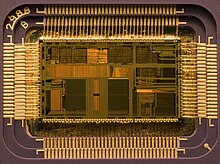A central processing unit (CPU) is the hardware within a computer that carries out the instructions of a computer program by performing the basic arithmetical, logical, control and input/output operations of the system. The term has been in use in the computer industry at least since the early 1960s.The form, design, and implementation of CPUs have changed over the course of their history, but their fundamental operation remains much the same.
A computer can have more than one CPU; this is called multiprocessing. All modern CPUs are microprocessors, meaning contained on a single chip. Some integrated circuits (ICs) can contain multiple CPUs on a single chip; those ICs are called multi-core processors. An IC containing a CPU can also contain memory, peripheral devices, and other components of a computer system; this is called a system on a chip (SoC).
Two typical components of a CPU are the arithmetic logic unit (ALU), which performs arithmetic and logical operations, and the control unit (CU), which extracts instructions from memory and decodes and executes them, calling on the ALU when necessary.
Contents
- 1.1 Transistor and integrated circuit CPUs
- 1.2 Microprocessors
- Operation
- 2.1 Fetch
- 2.2 Decode
- 2.3 Execute
- Design and implementation
Transistor and integrated circuit CPUs
The design complexity of CPUs increased as various technologies facilitated building smaller and more reliable electronic devices. The first such improvement came with the advent of the transistor. Transistorized CPUs during the 1950s and 1960s no longer had to be built out of bulky, unreliable, and fragile switching elements like vacuum tubes and electrical relays. With this improvement more complex and reliable CPUs were built onto one or several printed circuit boardscontaining discrete (individual) components.During this period, a method of manufacturing many interconnected transistors in a compact space was developed. The integrated circuit (IC) allowed a large number of transistors to be manufactured on a single semiconductor-based die, or "chip". At first only very basic non-specialized digital circuits such as NOR gates were miniaturized into ICs. CPUs based upon these "building block" ICs are generally referred to as "small-scale integration" (SSI) devices. SSI ICs, such as the ones used in the Apollo guidance computer, usually contained up to a few score transistors. To build an entire CPU out of SSI ICs required thousands of individual chips, but still consumed much less space and power than earlier discrete transistor designs. As microelectronic technology advanced, an increasing number of transistors were placed on ICs, thus decreasing the quantity of individual ICs needed for a complete CPU. MSI and LSI (medium- and large-scale integration) ICs increased transistor counts to hundreds, and then thousands.Microprocessors
In the 1970s the fundamental inventions by Federico Faggin (Silicon Gate MOS ICs with self-aligned gates along with his new random logic design methodology) changed the design and implementation of CPUs forever. Since the introduction of the first commercially available microprocessor (the Intel 4004) in 1970, and the first widely used microprocessor (the Intel 8080) in 1974, this class of CPUs has almost completely overtaken all other central processing unit implementation methods. Mainframe and minicomputer manufacturers of the time launched proprietary IC development programs to upgrade their older computer architectures, and eventually produced instruction set compatible microprocessors that were backward-compatible with their older hardware and software. Combined with the advent and eventual success of the ubiquitous personal computer, the termCPU is now applied almost exclusively to microprocessors. Several CPUs (denoted 'cores') can be combined in a single processing chip.Previous generations of CPUs were implemented as discrete components and numerous small integrated circuits (ICs) on one or more circuit boards.


